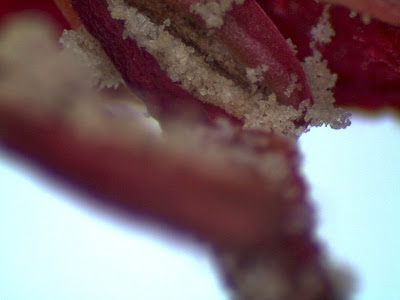_________________________________________________________________________________
_________________________________________________________________________________

Daisy (Bellis perennis)
Magnification: 35X
Leica Stereo Microscope
Taken by: Emily Robinson & Group
This a very detailed picture of the center of the Daisy. The carpels of the Daisy are very visible, each little carpel is a small flower of its own. Together all of the carpels make up the center of the Daisy.
This a detailed picture of the pollen grains that are on the Daisy. The yellow stands out strongly, making it easy to identify the Pollen.
This is also a close up picture of the pollen grains, once again the yellow color of the pollen makes it easier to locate it. The pollen is a lot of parts of the Daisy, its on the Carpels, on the Sepals, and on the Petals as well.
_________________________________________________________________________________
Fuchsia (Fuchsia magellanica)
Magnification: 35X
Leica Stereo Microscope
Taken by: Emily Robinson & Group
This is an amazing picture of all of the pollen grains that the anther of the flowers has caught.
This a very detailed picture of pollen grains that are located on the anther of the flower. Notice that the color of the pollen grains are distinct, because they are white.
This is a magnificent picture of the pollen grains that are located on the flower. This is an excellent photograph to see how closely the pollen grains are clustered together.
_________________________________________________________________________________
False Cedar ( Cedrus deodara)
Magnification: 35X
Leica Stereo Microscope
Taken by: Emily Robinson & Group
This is a picture of the pollen grains at the top of the pollen cone. The pollen is easy to identify because of its yellow color.
This a very clear and detailed photograph of the pollen grains that are located on the pollen cone of the tree. This photo shows how clustered the pollen grains are and also shows how much pollen is located on the pollen cone.

This is a detailed photo of the pollen grains that are on the pollen cone of the tree.








No comments:
Post a Comment